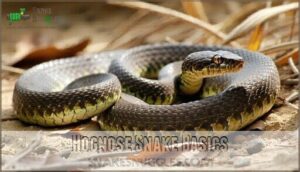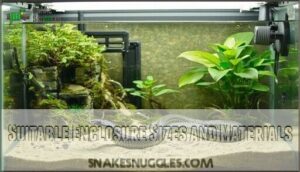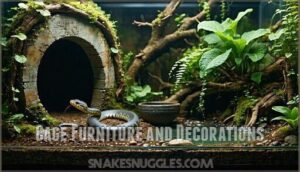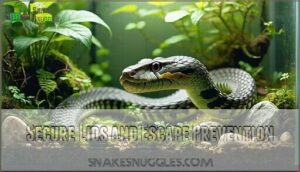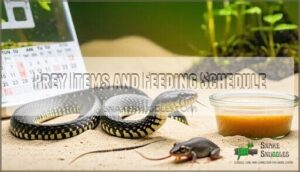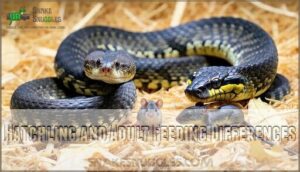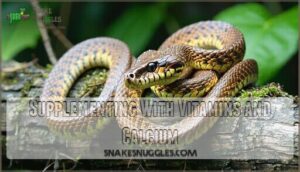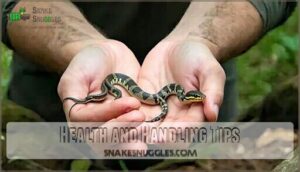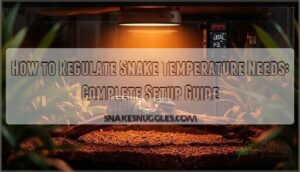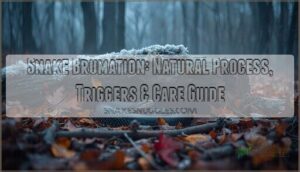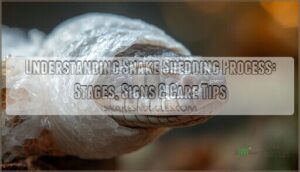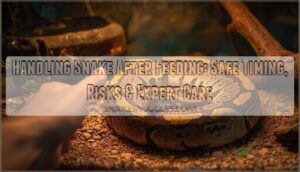This site is supported by our readers. We may earn a commission, at no cost to you, if you purchase through links.
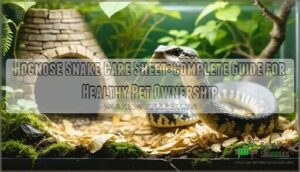 Your hognose snake care sheet starts with understanding these drama queens need a 40+ gallon terrarium with secure lids—they’re escape artists who’ll pretend to die when stressed.
Your hognose snake care sheet starts with understanding these drama queens need a 40+ gallon terrarium with secure lids—they’re escape artists who’ll pretend to die when stressed.
You’ll maintain temperatures between 75-95°F with a gradient, provide burrowing substrate like aspen shavings, and feed appropriately-sized frozen-thawed rodents every 7-14 days.
Handle them gently after they’ve settled in, watching for their famous defensive displays including hissing, hood-flaring, and theatrical death scenes.
These hardy snakes thrive with consistent care, proper humidity around 30-50%, and hiding spots on both warm and cool sides, and the secret lies in respecting their quirky personalities while meeting their specific environmental needs, which is key to their care and requires a gentle and consistent approach.
Table Of Contents
- Key Takeaways
- Hognose Snake Basics
- Housing and Enclosure
- Top 6 Hognose Snake Care Essentials
- Feeding and Diet Requirements
- Health and Handling Tips
- Frequently Asked Questions (FAQs)
- Do hognose snakes need a care sheet?
- How do I care for a western hognose snake?
- How do I choose a western hognose snake?
- How do you feed a western hognose snake?
- Where can I buy a hognose snake?
- How do I choose a western hognose snake enclosure?
- Can hognose snakes be housed together safely?
- How often do hognose snakes shed skin?
- What breeding requirements do hognose snakes need?
- Are hognose snakes venomous to humans?
- Conclusion
Key Takeaways
- You’ll need a 40+ gallon terrarium with secure, escape-proof lids since hognose snakes are notorious escape artists who can squeeze through surprisingly small gaps.
- Maintain a temperature gradient of 75-95°F with proper heating equipment and thermostats, plus 30-50% humidity with burrowing substrate like aspen shavings for their natural digging behavior.
- Feed frozen-thawed rodents every 7-14 days based on your snake’s age and size – juveniles need smaller prey more frequently, while adults eat larger meals less often.
- Handle them gently and infrequently (1-2 times weekly) while respecting their dramatic defensive displays, like hissing, hood-flaring, and playing dead, when stressed.
Hognose Snake Basics
You’ll find hognose snakes among the most rewarding pet reptiles, thanks to their manageable size and calm temperament.
These fascinating creatures belong to the Heterodon genus and make excellent choices for both beginners and experienced keepers, which is a key aspect of their appeal as pet reptiles.
Scientific Name and Classification
When exploring the fascinating world of hognose snakes, you’ll encounter the Genus Heterodon within the Colubrid family.
Species Diversity includes three North American colubrid types: western, eastern, and southern varieties.
The Western Hognose Snake (Heterodon nasicus or Heterodon nasiscus nasiscus) showcases remarkable Subspecies Variations. Understanding Taxonomy Importance and Evolutionary History helps you appreciate these fascinating serpents better.
Average Length and Lifespan
Most hognose snakes reach their adult size within two years, though growth rates vary between individuals.
Your hognose snake will double in size during its exciting first two years of growth.
Size sexual dimorphism is pronounced—males typically stay smaller at 15-25 inches, while females grow larger at 28-36 inches.
Your hognose snake lifespan averages 12-18 years in captivity, with proper care extending longevity factors up to 20+ years.
- Hatchling size: Newborns measure 6-9 inches at birth
- Maximum size: Females rarely exceed 36 inches in captivity vs wild specimens
- Growth timeline: Most reach adult proportions by 18-24 months
- Captivity advantages: Consistent feeding promotes steady, healthy development compared to wild counterparts
Color and Pattern Variations
Beyond size differences, you’ll find hognose snakes display remarkable diversity in their appearance.
Morph genetics create stunning variations, from classic wild-type patterns to exotic albino hognoses with reduced melanin. These genetic mutations produce incredible color phases that’ll make your head spin.
| Morph Type | Characteristics |
|---|---|
| Wild Type | Brown/tan base with dark blotches, natural pattern aberrations |
| Albino | Yellow/orange tones, red eyes, lacks dark pigmentation |
| Leucistic | Pure white with black eyes, color intensity completely absent |
Regional variations also affect appearance – western hognose morphs typically show more muted tones compared to their eastern cousins.
Snake color variations range from subtle pattern shifts to dramatic transformations that barely resemble their wild ancestors. Some morphs, like the snow western, combine traits and feature white scales and eyes.
Housing and Enclosure
Your hognose snake needs a proper home that prioritizes floor space over height since these ground-dwelling reptiles love to burrow and explore horizontally.
Hognose snakes thrive in spacious, horizontal habitats that accommodate their natural burrowing instincts.
You’ll want to focus on escape-proof design because hognose snakes are notorious Houdini artists who can squeeze through surprisingly small gaps.
Suitable Enclosure Sizes and Materials
Adult hognose snakes need at least a 20-gallon terrarium with secure, escape-proof lids—these slippery escape artists will exploit any gap.
Glass, PVC, or plastic materials work well, but avoid cedar substrates due to material toxicity.
Consider PVC for heat retention, as it surpasses glass in maintaining consistent temperatures.
Focus on floor space over height since these ground-dwellers prefer horizontal movement, and proper enclosure dimensions and space utilization create a stress-free environment for your snake, ensuring a suitable home with secure lids.
Cage Furniture and Decorations
Your snake enclosure needs key furniture pieces for comfort and security.
Place one hide box on each side of the temperature gradient, allowing your hognose to thermoregulate while staying hidden.
Add a sturdy water dish sized appropriately for soaking during sheds.
Include climbing branches for environmental enrichment, though hognose snakes aren’t avid climbers.
Live plants can enhance background decor while improving air quality.
For maximum comfort, consider a specialized snake enclosure.
Maintain adequate substrate depth around all hiding areas for natural burrowing behavior.
Secure Lids and Escape Prevention
Think of your hognose snake enclosure as Fort Knox—these escape artists will find any weakness.
Secure cage security requires tight-fitting lid materials with reliable locking mechanisms. Check all potential escape routes, especially around modified enclosures where gaps form.
Juvenile escapes happen fast, so your snake enclosure must be completely escapeproof with clasps or clips. For a truly secure setup, consider an escape proof terrarium.
Top 6 Hognose Snake Care Essentials
Setting up your hognose snake’s habitat correctly from day one prevents future health issues and reduces your stress as a new owner.
You’ll need six essential items to create a safe, comfortable environment that mimics their natural prairie habitat, which is crucial for preventing health issues and ensuring the well-being of your hognose snake.
1. REPTI ZOO 50 Gallon Terrarium
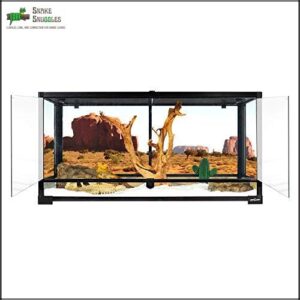
Setting up your hognose snake’s home doesn’t have to break the bank or your back. The REPTI ZOO 50 Gallon Terrarium measures 36" x 18" x 18", providing perfect floor space for your snake’s ground-dwelling lifestyle.
You’ll love the dual front-opening doors that make feeding and cleaning a breeze while preventing great escapes. The elevated base accommodates heat mats safely, and the removable mesh top allows proper UVB penetration.
Best of all, it assembles in just five minutes with included tools. Consider adding naturalistic hides to reduce stress, creating a more naturalistic environment for your pet.
Best For: Keepers seeking a durable, easy-to-assemble, and secure enclosure for adult hognose snakes or other similarly sized terrestrial reptiles.
- Back mesh panels can make sustaining high humidity more difficult.
- Instructions are only in English, which may pose a challenge for some users.
- Gaps may show if stacking multiple units, as no kit is provided to hide them.
- Spacious 50-gallon floor area supports natural burrowing and enrichment.
- Dual front-opening doors offer safe, convenient access for feeding and cleaning.
- Quick assembly with tools included and a strong warranty for peace of mind.
2. ReptiChip Coconut Reptile Bedding Substrate
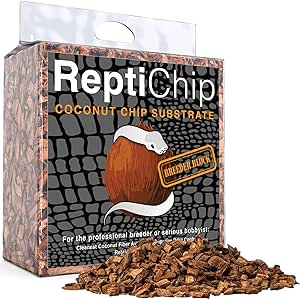
ReptiChip consistently delivers exceptional moisture retention and natural burrowing opportunities for your hognose snake.
This 100% organic coconut substrate expands from a compact brick into 72 quarts of premium bedding that’ll last months with proper spot-cleaning.
You’ll appreciate how it naturally absorbs odors while maintaining the 30-50% humidity your snake needs for healthy shedding.
The soft chip texture prevents impaction risks while encouraging natural digging behaviors that keep your hognose mentally stimulated and stress-free, with natural burrowing opportunities.
Best For: Hognose snake keepers who want effective humidity control, odor management, and a safe, natural substrate that encourages healthy burrowing.
- Some sharp pieces may require removal before use.
- Can be dusty during initial setup.
- More expensive and slower to ship than some local alternatives.
- Holds humidity well, reducing misting and maintenance.
- Absorbs odors effectively for a fresher enclosure.
- Soft coconut chips minimize impaction risk and support natural behaviors.
3. Zilla Reptile Terrarium Shale Rock Den
Why settle for a boring hide when you can give your hognose snake a naturalistic retreat?
The Zilla Reptile Terrarium Shale Rock Den combines form and function perfectly, providing essential security while adding visual appeal to your terrarium.
Its non-porous plastic construction resists bacteria and cleans easily with warm, soapy water, making it a practical choice for snake owners.
The elevated platform doubles as a basking spot, while the cave-like interior satisfies your snake’s instinct to burrow and hide, making it perfect for adult western hognose snakes up to 3 feet long, and offering a secure environment.
Best For: Owners of western hognose snakes and other small to medium reptiles seeking a realistic, low-maintenance hideout that supports natural behaviors.
- May be too small for larger reptiles or adult ball pythons.
- Some users report a chemical smell upon arrival that needs to be washed away.
- Appearance may differ slightly from photos, including unexpected color tinges.
- Realistic rock design blends seamlessly with terrarium environments and encourages natural hiding and burrowing.
- Non-porous, easy-to-clean plastic resists bacteria and odor buildup.
- Sturdy, tip-resistant construction with multiple hideouts and a basking platform.
4. iPower Seedling Heat Mat Thermostat
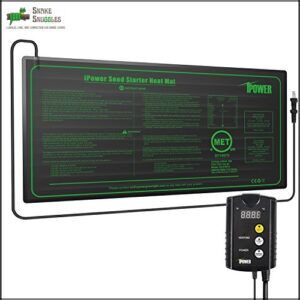
Accurate temperature control makes the difference between thriving hognose snakes and stressed reptiles.
The iPower thermostat maintains your heat mat within ±2°F of your target, preventing dangerous overheating that can burn your snake or desiccate substrate.
You’ll appreciate the digital display’s one-degree precision from 40-108°F, plus it remembers settings after power outages.
Place the probe between your heat mat and enclosure bottom for reliable surface readings that support proper thermoregulation.
Best For: Reptile and pet owners or indoor gardeners who want precise, reliable temperature control for heat mats.
- Digital thermostat ensures stable temperatures within ±2°F, reducing risk of burns or overheating.
- Easy-to-read display saves your settings through power outages and allows simple programming.
- Waterproof mat with durable construction fits a variety of uses, from snake enclosures to seed starting.
- Sensor placement is critical for accuracy and may take trial and error to get right.
- Not directly compatible in regions requiring a UK plug without an adapter.
- Probe and pad can’t be submerged, limiting cleaning and placement options.
5. Exo Terra Reptile Water Dish
Five reasons make the Exo Terra Water Dish essential for your hognose snake’s health. This food-grade resin bowl features safety steps that prevent drowning while allowing easy access for drinking and soaking.
The non-porous surface resists bacteria and cleans effortlessly with simple soap and water. Its realistic rock finish blends seamlessly with any terrarium theme, while the heavy construction prevents tipping by active snakes.
The smooth interior protects sensitive snake skin during use.
Best For: Owners of hognose snakes and other medium-to-large reptiles who want a safe, stable, and easy-to-clean water dish that matches natural terrarium setups.
- Heavier weight can make daily water changes challenging for some users.
- Sizes may differ from expectations; check dimensions before buying.
- May increase humidity in desert-style tanks, requiring more ventilation.
- Safety steps prevent drowning and allow easy access for smaller reptiles.
- Heavy, tip-resistant construction keeps water and bedding mess-free.
- Smooth, non-porous surface resists bacteria buildup and is easy to clean.
6. Fluker’s Reptile Tank Basking Lamp
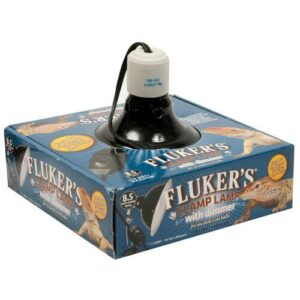
Proper basking temperatures keep your hognose snake healthy and active throughout the day.
Fluker’s basking lamps offer reliable heat output with adjustable wattage options from 40W to 150W, letting you create the perfect temperature gradient.
The ceramic socket handles high temperatures without melting, while the dimmer switch fine-tunes heat levels for seasonal changes.
Position the lamp outside your enclosure at appropriate heights to achieve target basking temperatures of 88-90°F without risking burns.
Best For: Reptile keepers needing a reliable, adjustable basking lamp to create precise temperature gradients for species like hognose snakes.
- Durable ceramic socket withstands high temperatures for safety and longevity.
- Adjustable dimmer switch for easy control of heat and light output.
- Multiple wattage options fit a variety of enclosure sizes and reptile needs.
- Some users report issues with LED bulb compatibility and occasional flickering.
- Clamp may not fit all tank setups, requiring alternative mounting solutions.
- Occasional product faults like bulb blowouts or the need for manual reset after power outages.
Feeding and Diet Requirements
You’ll need to establish a proper feeding routine that matches your hognose snake’s natural hunting instincts and nutritional needs.
Getting the diet right from the start prevents common health issues and guarantees your snake thrives throughout its 12-18 year lifespan.
Prey Items and Feeding Schedule
While frozen mice form the foundation of your hognose diet, prey size matters most—match the width of your snake’s thickest body part.
Frozen vs live? Choose frozen for safety and convenience.
Your feeding schedule depends on age: juveniles need meals every 5-7 days, adults every 10-14 days.
If your snake refuses food, try scenting prey with tuna juice—this trick often jumpstarts reluctant eaters who miss their natural amphibian meals. Some owners also offer African clawed frogs as an alternative food source.
Hatchling and Adult Feeding Differences
Your hatchling hognose snake requires substantially different feeding than adults.
Young snakes need smaller prey more frequently, while adults eat larger meals less often.
Key Feeding Differences:
- Prey Size – Hatchlings eat 2-3g pinky mice; adults handle medium to large mice matching their body girth
- Feeding Frequency – Feed hatchlings every 4-5 days; adults every 10-14 days to prevent obesity
- Scenting Prey – Hatchlings often need tuna or chicken-scented prekilled prey to initiate feeding; adults rarely require this
- Live vs. Frozen – Both ages do well with frozen-thawed rodents, avoiding live prey risks
Supplementing With Vitamins and Calcium
Your hognose snake’s calcium and vitamin supplements support healthy bone development and metabolic function.
Dust prey items with calcium plus vitamin D3 once weekly, alternating with multivitamins.
Watch for deficiency symptoms like lethargy or poor shedding, but avoid over-supplementation risks that cause organ damage.
Consider hognose calcium options for ideal health.
Natural alternatives include varied prey types for thorough reptile care and superior hognose health.
Health and Handling Tips
Keeping your hognose snake healthy requires understanding their unique behaviors and watching for warning signs that something’s wrong.
You’ll need to master gentle handling techniques while creating the right environment to prevent common health issues before they start, which is crucial for maintaining your snake’s overall health.
Avoiding Bites and Stress Reduction
Four key handling techniques keep your hognose snake calm and bite-free.
Always wash your hands before handling to remove prey scents, approach from the side rather than above, and support their body fully.
Limit sessions to 1-2 times weekly, avoiding handling during feeding, shedding, or when they’re displaying defensive behaviors like hissing or playing dead.
New owners should also be aware of their unique defensive behaviors.
Recognizing Signs of Illness and Disease
After keeping stress low, stay alert for health red flags.
Lethargy signs, trouble eating, or open-mouth breathing could point to respiratory infections or mouth rot.
Watch for scale rot, shedding issues, or red belly scales—these mean your hognose snake needs a reptile vet.
One key indicator is unusual lethargy, such as staying in one spot for extended periods.
If you spot bubbling, wheezing, or persistent hiding, don’t wait; snake health depends on quick action.
Providing a Humid Hide and Temperature Gradient
When maintaining proper environmental conditions, you’ll create a foundation for ideal hognose snake health and successful shedding cycles.
Temperature regulation requires precise monitoring to prevent respiratory issues and thermal stress.
- Humidity Monitoring: Maintain 30-50% for Western species, 50-60% for Eastern/Southern varieties using digital hygrometers
- Basking Spot: Establish 86-90°F warm zone with 75-80°F cool side for proper gradient importance
- Shedding Aid: Place humid hide with moist sphagnum moss on cooler side for complete sheds
- Temperature Regulation: Use accurate thermostats and multiple monitoring points throughout enclosure
Frequently Asked Questions (FAQs)
Do hognose snakes need a care sheet?
You’ll want a detailed roadmap since these unique serpents aren’t your typical pet.
Proper care sheets provide essential guidance on housing, feeding, temperature, and humidity requirements that’ll keep your scaly friend healthy and thriving for years.
This will ensure you have all the necessary information to provide the best possible environment for your pet.
How do I care for a western hognose snake?
You’ll need a 20-gallon tank with secure lid, aspen substrate for burrowing, temperature gradient of 75-90°F, 30-50% humidity, and feed frozen mice weekly.
How do I choose a western hognose snake?
You’ll want to find a reputable breeder (not some snake oil salesman!) who provides healthy, well-socialized hognose snakes with proper documentation and feeding records for best results.
How do you feed a western hognose snake?
Feed your western hognose snake pre-killed frozen mice every 7-10 days.
Choose prey roughly matching your snake’s thickest body section.
Thaw completely in warm water before offering with feeding tongs for safety.
Where can I buy a hognose snake?
Ironically, finding these "difficult" snakes is surprisingly easy.
You can purchase hognose snakes from reputable reptile breeders, online vendors like MorphMarket, local pet stores, or reptile expos for $50-300 depending on morph.
How do I choose a western hognose snake enclosure?
Choose a 20-gallon long tank (30x12x12 inches) for adult Western hognose snakes.
Prioritize floor space over height since they’re ground-dwellers.
Make certain secure, escape-proof lids—these snakes are notorious escape artists who’ll exploit any gap.
Can hognose snakes be housed together safely?
No, hognose snakes shouldn’t be housed together.
Multiple adults should be kept separately to avoid stress and feeding issues.
They’re solitary creatures that thrive when given their own space and resources.
How often do hognose snakes shed skin?
You’ll notice your hognose snake sheds its skin every 4–6 weeks as a juvenile, but adults shed less often—about every two to three months.
Think of it as your snake’s way of getting a fresh outfit!
What breeding requirements do hognose snakes need?
Like your great-great-grandfather’s farming almanac, you’ll need patience and timing.
Brumation requires gradually dropping temperatures to 50-60°F after two weeks without feeding.
This cold period lasts 2-3 months before gradually warming triggers breeding season.
Are hognose snakes venomous to humans?
Western and eastern hognose snakes are virtually harmless to humans, producing only mild venom that rarely affects people. You’d need to experience a prolonged bite for any reaction.
Conclusion
Like a well-orchestrated symphony, successful hognose snake care requires harmonizing multiple elements to create the perfect environment.
This hognose snake care sheet provides you with the essential knowledge needed to keep your theatrical serpent healthy and content.
You’ll create an ideal habitat by maintaining proper temperatures, providing adequate hiding spots, and establishing consistent feeding routines.
Remember that patience is key when working with these dramatic performers—they’ll reward your dedication with years of fascinating behaviors and relatively low-maintenance companionship in your home, making them a great choice for those who value low-maintenance and fascinating pets.

